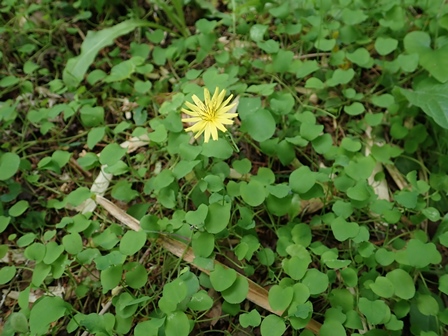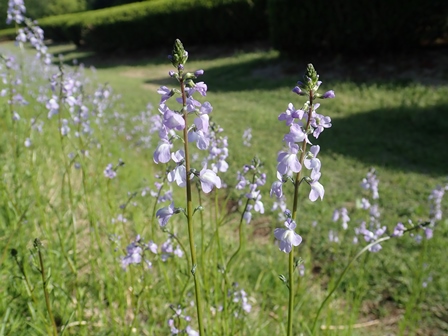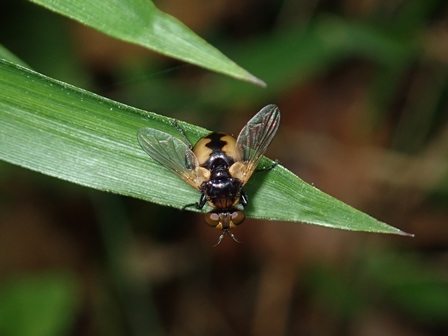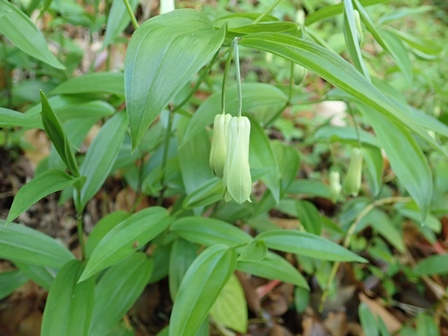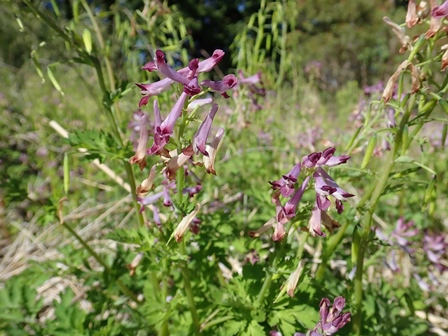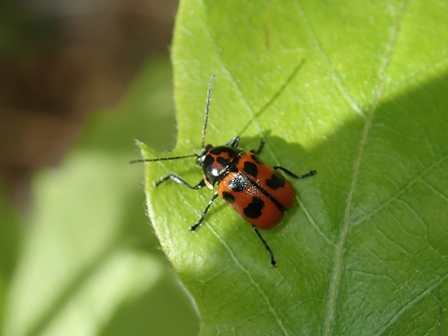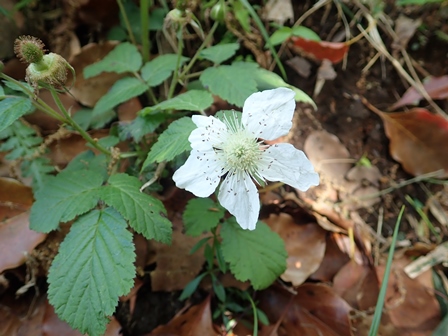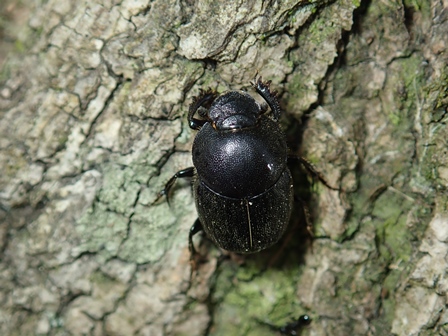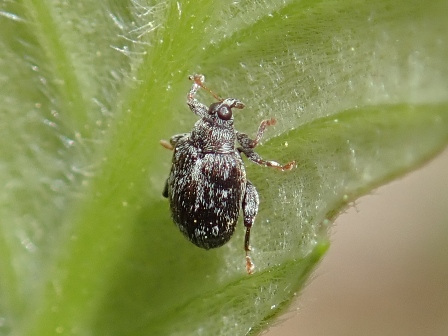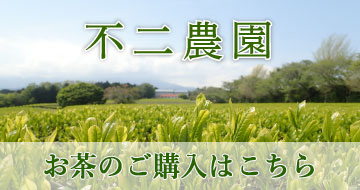フィールド日記
2021.05.14
コゴメウツギ
校舎の裏でコゴメウツギが咲いています。和名のコゴメは小米の意味で、白い小さい花が多数つくことに由来します。太平洋側に多く、不二聖心でもよく見られますが、日本海側には少ないようです。
"Kogome-Utsugi (コゴメウツギ)" trees are in bloom behind the school building. "Kogome (コゴメ)" in its name means crushed rice and comes from their white small flowers. They are often seen on the Pacific side and they are often seen in Fuji-Seishin as well, but they are less seen on the Japan Sea side.
2021.05.11
イワニガナ
道路わきにイワニガナが咲いています。別名をジシバリ(地縛り)といい、茎が横にはって伸びていき、所々で根を下ろしていくため、地面をおおうように成長することに由来します。近縁種に、より大型のオオジシバリがあり、不二聖心では両方見ることができます(オオジシバリの記事はこちら)。
"Iwanigana (イワニガナ)" plants are in bloom along the roadside. They are also called "Jishibari (ジシバリ)" and it came from the way how they extend their stems on sideways and root here and there. Their close relative species are called "Oo-Jishibari (オオジシバリ)". They are literally larger than "Iwanigana (イワニガナ)". You can find both in Fuji-Seishin. (Click here to read the article about the "Oo-Jishibari (オオジシバリ)".
2021.05.07
マツバウンラン
お茶畑でマツバウンランが群生しています。北アメリカ原産の帰化植物で、道端や芝生などでよく見られます。1941年に京都市で初めて見つかり、その後分布を広げ、2000年代には関東地方の都市部でも多く見られるようになったようです。
"Matsuba-Unran (マツバウンラン)" plants grow gregariously in the tea field. They came from North America and are often seen along the roadside and in lawn, etc. They were found in Kyoto city in 1941 for the first time and have expanded their habitats. In the 2000s, they started to flourish even in the urban area of the Kanto region.
2021.05.04
マルボシヒラタハナバエ
クヌギ林でマルボシヒラタハナバエを見つけました。体は丸みを帯びていて、黄色い腹部には黒い紋があります。ヤドリバエの仲間で、成虫は花に集まりますが、幼虫はカメムシに寄生します。
I found a "Maruboshi-Hirata-Hanabae (マルボシヒラタハナバエ)" in the Japanese chestnut oak woodland. Their bodies are roundish and their yellow abdomen has a black pattern. They belong to the tachina fly group. While the adults gather in flowers, the larvae parasitize stink bugs.
2021.04.30
ホウチャクソウ
校舎裏の斜面にホウチャクソウが咲いています。和名は、花の形が寺院に飾りとしてつるす宝鐸(ほうちゃく)と呼ばれる風鈴に似ていることに由来します。
"Houchaku-Sou (ホウチャクソウ)" plants are in bloom on the slope behind the school building. "Houchaku (ホウチャク)" in its name refers to the wind bells that are hung from the roof of temples as ornaments.
2021.04.27
ムラサキケマン
キャンプ場でムラサキケマンが咲いています。同じ仲間の中では最も普通で、道端や空き地などで見られます。花は、「距(きょ)」と呼ばれる花弁の一部が後方に袋状に突き出した構造を持っています。距の中には蜜が分泌されています。
"Murasaki-Keman (ムラサキケマン)" plants are in bloom in the campsite. They are the most common in the Kikeman group and grow along roadsides and vacant lands. Their flowers have a "spur", a backward bag-shaped feature that is a part of the petal sticking out. They produce nectar in the spur.
2021.04.23
クロボシツツハムシ
共生の森でクロボシツツハムを見つけました。コナラなどの広葉樹の葉を食べるハムシの仲間です。オレンジ色の体に黒い斑点があり、一見するとテントウムシのようです。多くの昆虫が、毒をもつテントウムシに擬態することで天敵から身を守っており、クロボシツツハムシもその1種と考えられます。
I found a "Kuroboshi-Tsutsuhamushi (クロボシツツハムシ)" in the Kyoseinomori-Forest (共生の森). They are leaf beetles that eat broad leaf trees such as Konara oak trees. They have black spots on their bright orange-base body so they look like a ladybug. Many insects mimic toxic ladybugs to protect themselves from their predators. "Kuroboshi-Tsutsuhamushi (クロボシツツハムシ)" is one of those insects.
2021.04.20
クサイチゴ
校舎の裏でクサイチゴの花が咲いています。背丈が低いため草と名前についていますが、木イチゴのなかまです。赤く熟した果実は食用になります。
"Kusa-Ichigo (クサイチゴ)" trees are in bloom in the backyeard of the school building. Though they are named "Kusa (クサ)", which means "weed", they don't grow tall. They are a wild raspberry and categorized as a woody plant. The red ripe fruits are edible.
2021.04.16
フトカドエンマコガネ
共生の森でフトカドエンマコガネを見つけました。食糞性コガネムシの一種です。今回は、古いシイタケのホダ木についていました。動物の糞だけでなく、腐ったキノコに集まることもあるようです。
I found "Futokado-Enmakogane (フトカドエンマコガネ)" in the Kyoseinomori-Forest (共生の森). They are a dung beetle. I found one on an old shiitake mushroom log. The beetles seem to gather not only on excrement but also on rotten mushrooms.
2021.04.13
ガロアノミゾウムシ
共生の森のコナラの葉の上で、ガロアノミゾウムシを見つけました。ノミゾウムシという名前の通り、2.5mmほどの小さいからだと、象の鼻のような長い口吻をもっています。幼虫は葉の内側に潜って生活しています(ガロアノミゾウムシの幼虫について記事はこちら)。
I found a weevil called "Garoa-Nomi-Zoumushi (ガロアノミゾウム)" on Konara oak leaf in the Kyoseinomori-Forest (共生の森). "Nomi (ノミ)" and "Zou (ゾウ)" mean "flea" and "elephant" respectively. They have a small body of about 2.5 mm in size and a long proboscis looking like elephant's nose. Their larvae live inside the leaves (Click here to read the article about the larvae of "Garoa-Nomi-Zoumushi").



